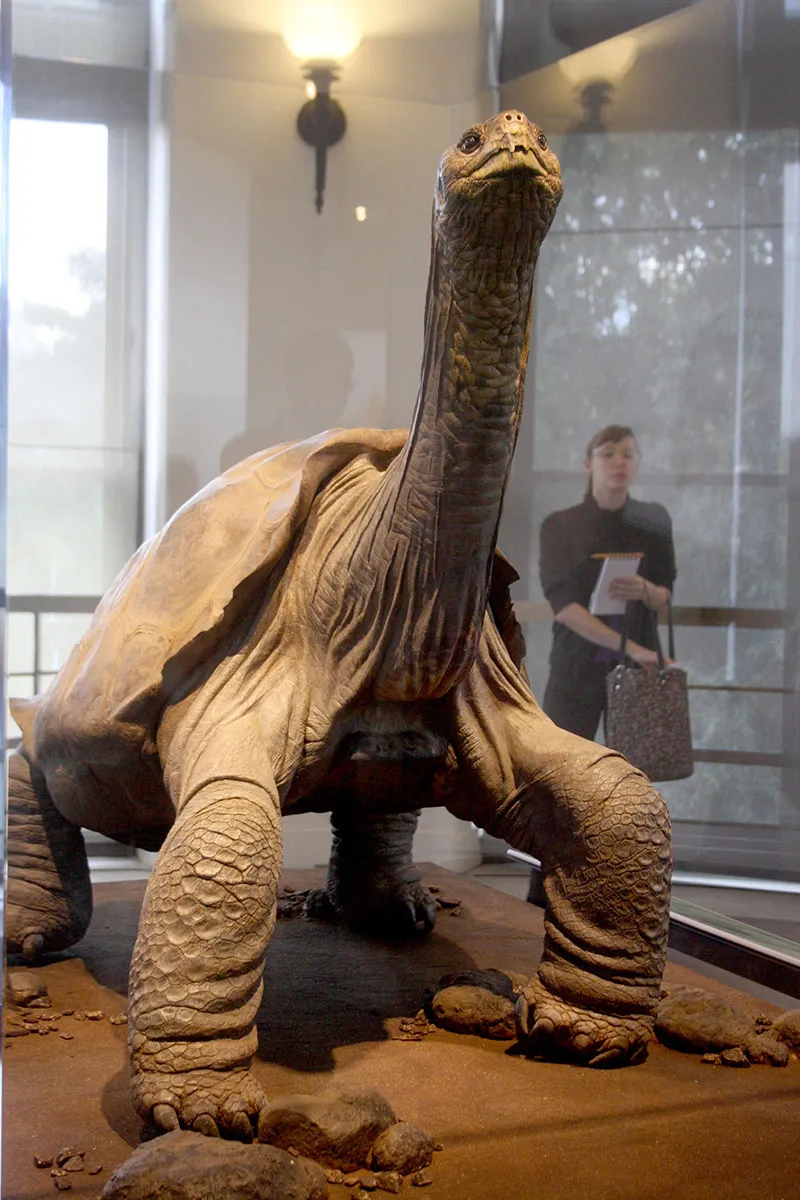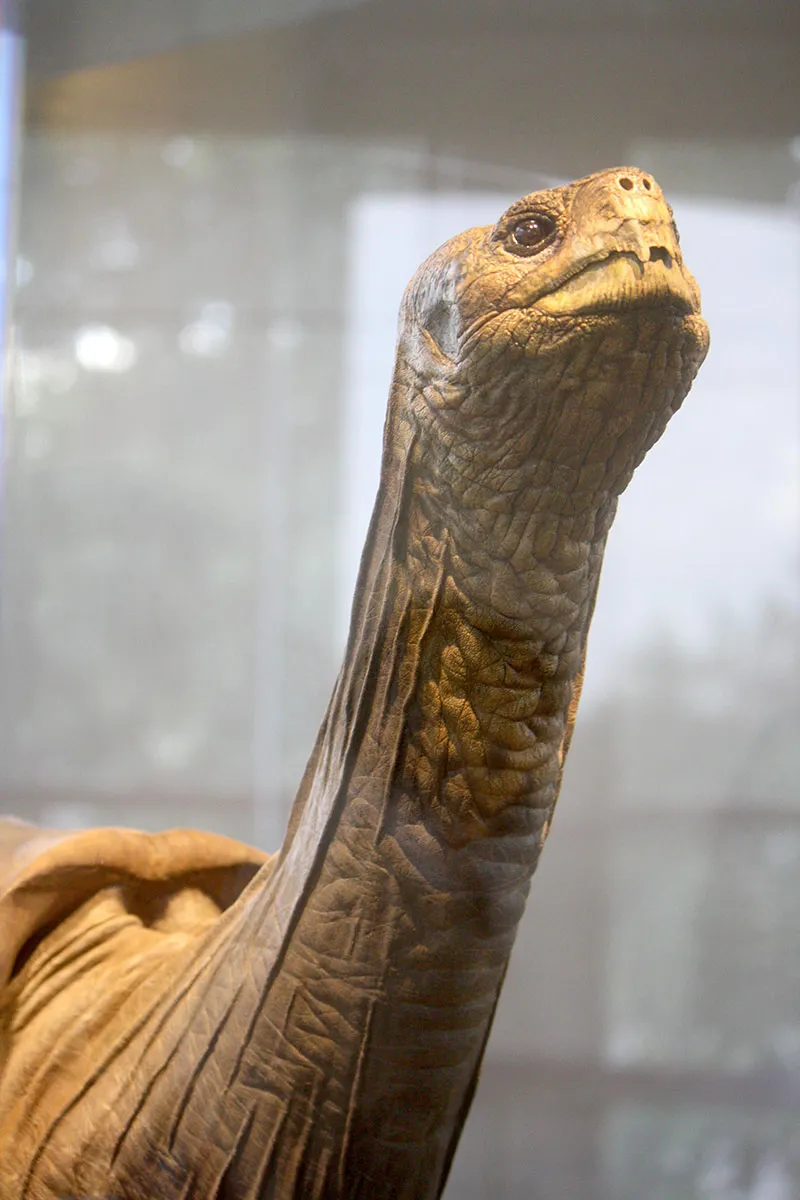Lonesome George, the Last Tortoise of His Kind, Is on Posthumous Display in NYC
Driven to extinction by overhunting, the world’s last Pinta Island tortoise is now a taxidermy display at New York’s American Museum of Natural History
:focal(1925x648:1926x649)/https://tf-cmsv2-smithsonianmag-media.s3.amazonaws.com/filer/ba/b1/bab171ba-cff5-4ea8-a7da-648701a36965/42-62248715.jpg)
Two years ago, the last known giant tortoise from Pinta Island in the Galápagos, Lonesome George, died at the age of about 100. Now through January, those interested in laying eyes on George's lengthy neck and beautiful saddleback shell can see him in taxidermied form at the American Museum of Natural History in New York City.
Pinta Island was once a haven for large tortoises from the Chelonoidis nigra abingdoni subspecies, but environmentalists assumed they had gone extinct in the early 20th century due to overhunting by humans. To the surprise of the world, Lonesome George was found—very much alive—in 1971 by a snail biologist. Deemed to be the last surviving member of the subspecies, he was transferred to the Charles Darwin Research Station in the Galápagos. Biologists hoped that George would sire offspring with a related species of tortoise, but while he lived for 13 years with two potential mates, all 13 eggs produced during that time were infertile. On the morning of June 24, 2012, Lonesome George was found dead in his corral by his caretaker. He died, scientists later determined, from natural causes. His death shocked those who cared for him due in part to his young age—giant tortoises from George's particular subspecies can live to be 200.

In 2013, researchers defrosted Lonesome George from the deep freeze he'd been kept in since his death and unpacked him in a New Jersey studio, where taxidermists set about preserving the giant tortoise for posterity. The preservation effort, which cost upwards of $30,000, took more than a year. The taxidermists chose to position George in a stance that displayed his unique evolutionary adaptations: showing off his saddleback shell and outstretched long neck, which helped George and other Pinta Island tortoises feast on plants a bit higher than ground level. They also chose to paint green marks on his neck to give the illusion that George had just eaten. Though George's exterior—skin and shell—are original, his internal organs have been replaced with foam. Alive, Lonesome George weighed 165 pounds, while the taxidermied specimen weighs in at just 50 pounds.

Though Lonesome George might be one of the most famous faces of extinction, he's far from the only animal driven to obsolescence in the modern age. In fact, he's one of an estimated dozens of species to go extinct every day. Extinction naturally occurs at an estimated rate of one to five species each year. Today, in the midst of what some scientists are calling a sixth mass extinction event, species are disappearing 1,000 to 10,000 as fast. Following current trends, some scientists believe that by the middle of this century, between 30 and 50 percent of the world's species could face the threat of extinction. For nearly all of these species, the most pervasive threat is human activity, which destroys natural habitat and introduces invasive species and disease. Humans are certainly responsible for the incredible decrease in Galápagos' tortoises, whose population used to number 200,000. Today, fewer than 20,000 giant tortoises survive there.
For recently extinct creatures, taxidermy offers a unique opportunity to faithfully preserve the animal. Creatures driven to extinction centuries ago—such as the dodo—now mostly exist as artistic representations. But for species whose demise has occurred in the recent past, there's often a swell of public support to preserve the last animal's body and place it on display. Icelanders, for example, raised the equivalent of more than $16,000 in order to buy the last auk—a flightless bird whose population once existed in the millions, but was driven to extinction via hunting—and bring it back to Iceland for exhibition. The auk sat on display in Iceland's Natural History Museum in Reykjavik until 2008, when the museum had to abandon plans for a larger exhibition space dedicated to the animal. Today, the stuffed bird sits alone in a storage facility.
Another taxidermied bird—Martha the Passenger Pigeon—met a similar fate, succumbing to extinction due to overhunting, habitat degradation and population variation. When Martha met her demise in 1914, her body was placed on ice and eventually taxidermied, after which it went on display in the Smithsonian's National Museum of Natural History. Martha was temporarily taken down when the museum replaced the exhibition dedicated to taxidermied extinct birds (including a great auk) with the Hall of Mammals. In remembrance of the 100th anniversary of her death, however, Martha is once again on display at the Natural History Museum as part of an exhibition featuring other iconic extinct birds of North America (open to the public until October 2015).
Lonesome George will be on display at the American Museum of Natural History through January 4, 2015, but what happens to his body once the exhibition sunsets remains a subject of heated debate. The Ecuadorian government feels that George should return to the capital city of Quito, where he can be seen by the greatest number of visitors, but the local mayor of the Galápagos believes that George should return to the breeding center where he spent the final 40 years of his life.
Planning Your Next Trip?
Explore great travel deals
Smithsonian magazine participates in affiliate link advertising programs. If you purchase an item through these links, we receive a commission.
/https://tf-cmsv2-smithsonianmag-media.s3.amazonaws.com/accounts/headshot/natasha-geiling-240.jpg)
/https://tf-cmsv2-smithsonianmag-media.s3.amazonaws.com/accounts/headshot/natasha-geiling-240.jpg)